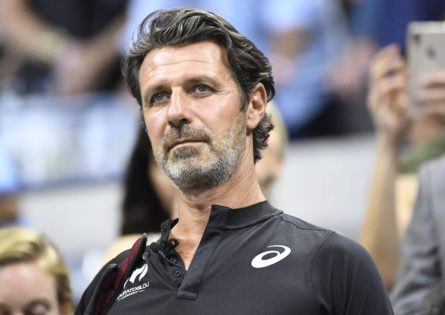Have you ever sat through an incredible tennis match? A long, hard, grueling competition between two players giving it their all on the grand stage before an audience of thousands? Think back to the 2006 Italian Open Final when Roger Federer and Rafael Nadal battled it out for five hours and five minutes for a shot at the title. Although Rafa came up as the eventual champion with a winning score of 6-4, 6-4, 6-7(5), 6-7(8), 9-7, the match itself was electrifying. But it doesn’t cut down the exhaustion the players face after the match. Would a legendary coach like Patrick Mouratoglou agree?
Patrick Mouratoglou, the former coach of WTA legend Serena Williams, recently highlighted the issues tennis needs to solve. In a series of Instagram videos on April 1, he addressed one pressing concern: the grueling hours players spend on the court. He noted, “About finishing late. It’s not easy because of the format of tennis that you never know is going to end. So, when you start five sets of a five-set match at ten, you can finish at 2 am, 3 am, maximum. But is it bad for the players? 100%. It’s terrible.” Mouratoglou emphasizes that the unpredictable match length is a significant problem.
Tennis players often face significant challenges during prolonged matches. The physical demands can be extreme, with matches burning over 6,000 calories and depleting energy stores, leading to fatigue and increased injury risk. Mentally, players must maintain focus and resilience over extended periods, which can be taxing. Mouratoglou highlights this issue, saying, “It’s terrible because people have to understand that when you finish a match at 2am, you need 3 to 4 hours to calm down because the adrenaline is extremely high and you can’t go to sleep. You need the treatment, the press, you have this, you have that. So probably you go to bed at 6 am, you need to recover the next day because you’re playing again one day later.”
This concern comes after the Professional Tennis Players Association (PTPA) released its lawsuit against tennis’ governing bodies about the unfair treatment of lower-ranked tennis players. In their lawsuit, they criticized the tennis schedule as unsustainable. They argue that the ATP organizes over 60 tournaments annually for male players, leaving scant time for rest and recovery. The PTPA emphasizes that this schedule forces players into an unsustainable routine of 45 weeks per year, which jeopardizes their health and safety.
However, Mouratoglou also noted, “I don’t want to blame ATP for that or Grand Slams, because again, the format of tennis with no ending, you don’t know when is going to end. Makes it extremely difficult.” Players often show up to tournaments exhausted. This is evident in the experiences of top players like Jannik Sinner, who played at the 2024 Shanghai Masters right after competing at the China Open, reaching a brutal final match against Carlos Alcaraz just two days prior.
Jannik Sinner then battled through fatigue to conquer Novak Djokovic, 6-2, 6-7 (0), 6-4, and reach the Grand Final of the inaugural Six Kings Slam. During his press conference, he noted, “Today, I felt like we both made some mistakes, which is normal. We were slightly tired. This is quite normal. Hopefully, we can recover in the best possible way for Saturday, him for his match, me for my match. Then, we’ll see.” While he was glad with how he handled the match, it was a close call due to the fatigue he faced.
And he’s not alone in his thoughts about it. Tennis players repeatedly mention the strain of playing back-to-back matches on their mental and physical well-being.
Players open up about the hectic tennis schedule and its effects
Last year, Iga Swiatek, the women’s former world No. 1 and a five-time Grand Slam champion, voiced her concerns about the grueling tennis schedule. She highlighted how it leaves players with little time to rest between tournaments, making it challenging to maintain peak performance week after week. After winning the Madrid Open, Swiatek noted, “Even if I win [a tournament], it doesn’t stick in my head. I celebrate for one day, then I’m off to another tournament… in my head. We don’t have time to rest properly. You have to use these days [between long-running events] and treat them a little bit like days off.”
Additionally, the expansion of tournaments like Madrid and Rome to nearly two weeks has been a boon for organizers but a burden for players. These events, modeled after Grand Slams, are seen as mere warm-ups for major tournaments like Roland Garros. Victoria Azarenka, a former No. 1, aptly described the situation: “We wanted more drama and then we stretched the drama a bit too much, where it kind of becomes like the ‘telenova’ that was too many seasons.” She hoped for adjustments, as the current format is too long.
The top players, including Stefanos Tsitsipas and Alexander Zverev, echoed similar sentiments. Tsitsipas humorously suggested that one needs to be a “superhero” to consistently perform well in back-to-back tournaments. Zverev pointed out that while the two-week format benefits lower-ranked players, it’s not ideal for top players, who end up spending more time away from home. “Resting is when you’re spending time at home, when you’re sleeping in your own bed,” Zverev emphasized.
As voices continue to rise against the demanding schedule, it remains to be seen whether these concerns will lead to changes or persist as the norm in tennis.
The post “Terrible” Tennis Hours Trashed Brutally by Serena Williams’ Former Coach as ATP Players Continue to Struggle appeared first on EssentiallySports.
